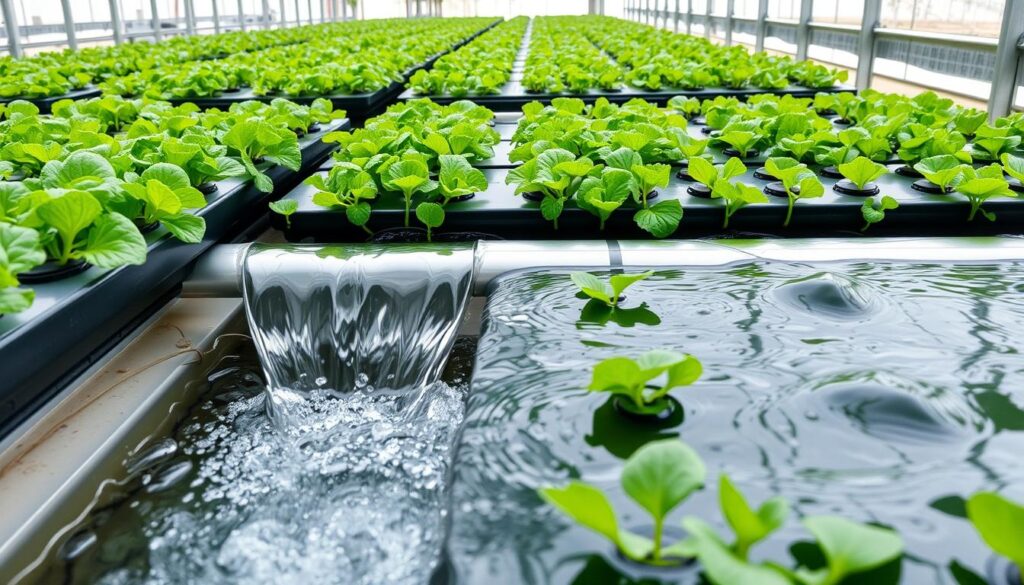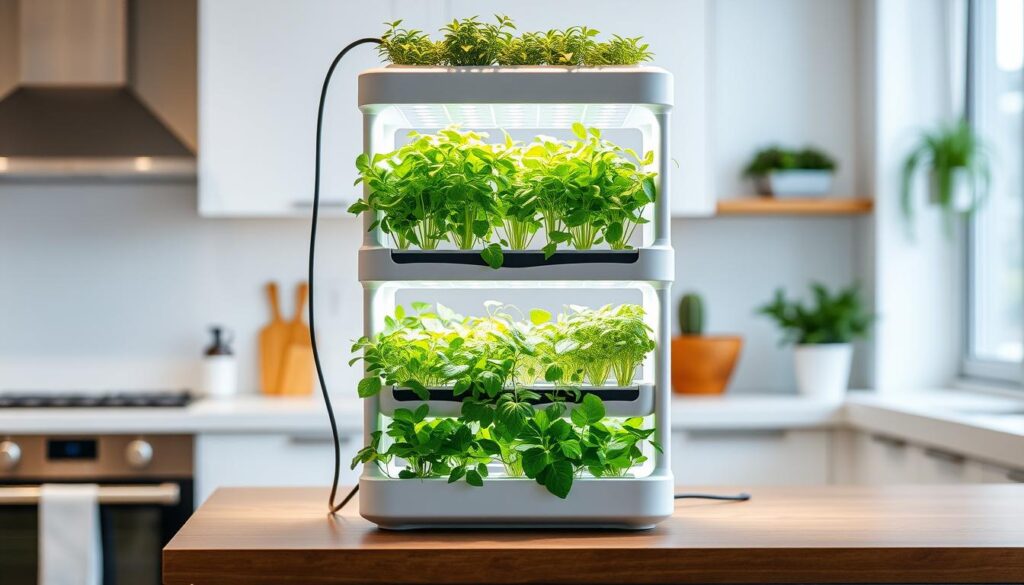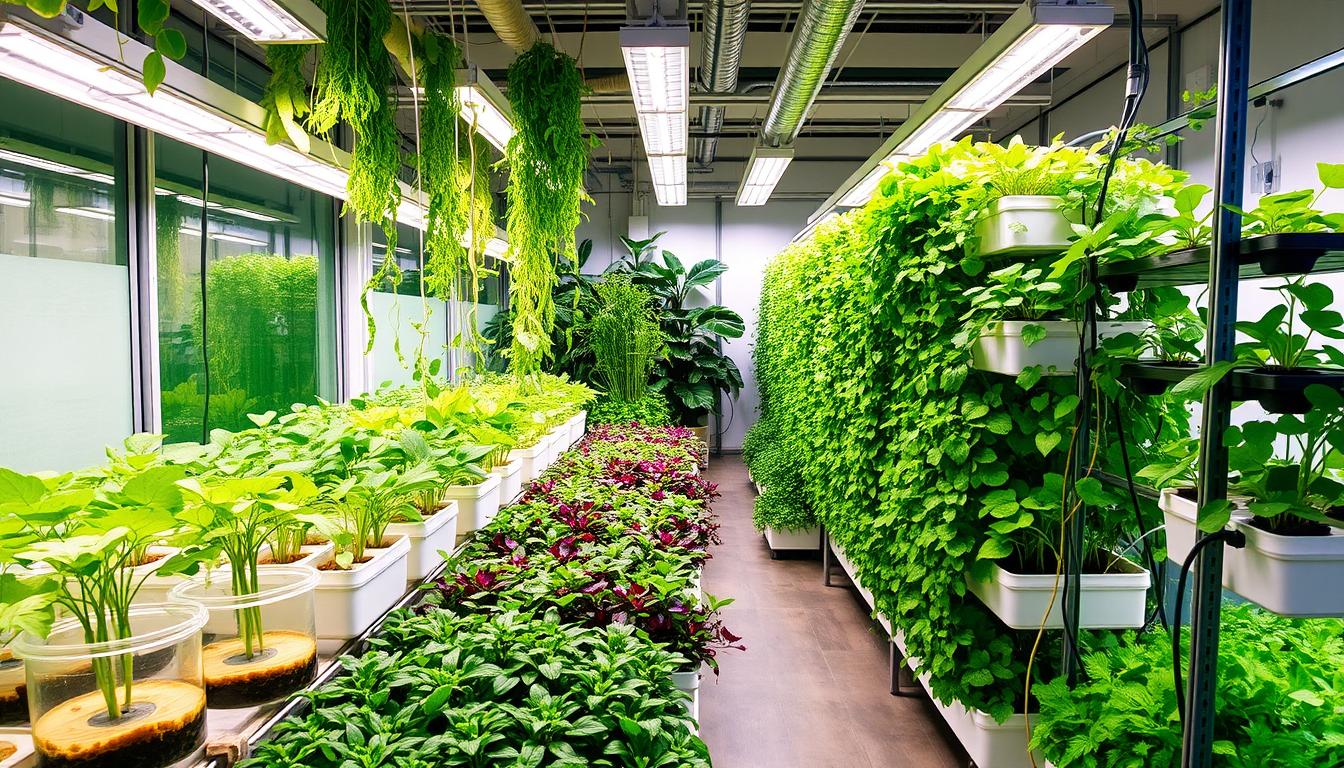Hydroponic systems grow plants without soil. They offer many benefits like more crops, saving water, and using less land. There are many types of hydroponic systems, making it hard to pick the right one.
It’s important to know about the different hydroponic systems. This knowledge helps you choose the best one for your needs. Hydroponic systems are popular because they are efficient and effective. By learning about the various types, you can make a smart choice and start your hydroponic journey.
Hydroponic systems come with many benefits, like growing more crops and saving water. Picking the right system helps your plants grow better and is good for the environment. With the right system, you can have a big harvest while using less water and land.
Key Takeaways
- Hydroponic systems offer increased crop yields and water conservation
- There are various hydroponic systems types to choose from, including hydroponic growing systems
- Understanding the different hydroponic systems is crucial for selecting the best one for your needs
- Hydroponic systems can help reduce land use and environmental impact
- Choosing the right hydroponic system can optimize plant growth and reduce water usage
Understanding the Basics of Hydroponic Systems
Hydroponic growing systems are becoming more popular. They are efficient and effective. But, what are they, and how do they work? These systems grow plants in a nutrient-rich solution, not soil. This method boosts crop yields and cuts down water use.
Hydroponics grows plants without soil, using a nutrient-rich solution. It’s different from traditional gardening, where plants grow in soil. Hydroponics offers many benefits, like higher yields and less water use.
What is Hydroponics?
Hydroponics is a way to grow plants without soil. It uses a nutrient-rich solution to feed the plants. This method has been around for centuries but is now more popular for its efficiency.
How Hydroponic Growing Differs from Traditional Gardening
Hydroponic growing is different from traditional gardening. In traditional gardening, plants grow in soil. Soil provides nutrients and support. In hydroponics, plants grow in a nutrient-rich solution, giving them all they need.
Core Components of Any Hydroponic Setup
Any hydroponic setup has a few key parts. There’s a reservoir, pump, tubing, and grow medium. The reservoir holds the nutrient solution. The pump moves the solution to the plants. Tubing connects the reservoir to the plants. The grow medium supports the plants.
Knowing these basics is key to choosing the right hydroponic system. It helps ensure your plants grow well. By understanding hydroponics, you can make smart choices for your garden and enjoy its benefits.
| Component | Description |
|---|---|
| Reservoir | Holds the nutrient-rich solution |
| Pump | Circulates the solution to the plants |
| Tubing | Connects the reservoir to the plants |
| Grow Medium | Provides support for the plants |
Benefits of Growing Plants Without Soil
Hydroponic systems have many advantages of hydroponic gardening. They help grow more plants and save water. Plants in hydroponic systems get the right temperature, humidity, and light. This makes them healthier and more productive.
The benefits of hydroponic systems also include using less land. You can even grow plants in places with bad soil. This is great for gardeners, farmers, and city growers. Some main benefits are:
- Increased crop yields
- Water conservation
- Reduced land use
- Better control over the growing environment
- Reduced need for pesticides and fertilizers
For hydroponic systems for beginners, learning the basics is key. With the right knowledge and tools, anyone can start growing plants hydroponically. They’ll enjoy all the benefits it offers.
Deep Water Culture (DWC): The Beginner’s Gateway to Hydroponics
Deep water culture, or DWC, is a great choice for beginners. It’s simple to set up and keep running. Plants float in a solution full of nutrients, with their roots growing freely. It’s perfect for growing lettuce, herbs, and tomatoes, making it ideal for newbies.
DWC is all about giving plants a steady supply of nutrients. This makes it perfect for growing indoors, even in small spaces. With the right care, DWC can help you grow a wide range of plants effectively.
How DWC Systems Work
DWC systems keep plants’ roots in a nutrient-rich solution. This lets them soak up the nutrients they need. It’s often paired with other methods like ebb and flow or drip systems. DWC creates a controlled space that helps plants grow well.
Ideal Plants for DWC
Some plants do better in DWC than others. Lettuce, herbs, and tomatoes love the constant nutrient flow. Cucumbers and peppers can also grow in DWC, but might need extra support or pruning.
Setup and Maintenance Requirements
To start a DWC system, you’ll need a reservoir, pump, and tubing. Keeping the system clean and checking the solution’s pH and nutrient levels is key. Following these steps can help you create a thriving hydroponic garden.
Nutrient Film Technique: Mastering Continuous Flow
The nutrient film technique (NFT) is a favorite for growing hydroponic systems for leafy greens like lettuce and spinach. It keeps a steady flow of nutrient-rich solution to the plants. This ensures they always get the nutrients they need.
In an NFT setup, plants hang in a long, narrow channel. The nutrient solution flows through this channel. This nutrient film technique is very efficient and can lead to high yields. It’s also easy to start and keep up, perfect for beginners in hydroponics.
Using hydroponic systems for leafy greens has many benefits. It increases crop yields, uses less water, and boosts plant health. The nutrient film technique also lets growers control nutrient levels precisely. This helps in optimizing plant growth. With proper care, nft hydroponics is a top choice for growing leafy greens.
Setting up an NFT system requires careful planning. You need to think about channel length, pump size, and the nutrient solution’s makeup. Knowing the nutrient film technique and nft hydroponics well helps growers get the most out of their system.
Wick Systems: The Most Simple Hydroponic Method
Wick systems are easy to use and perfect for small gardens. They are great for beginners. Plants sit in a medium, and a wick pulls nutrient solution from a reservoir.
Understanding Wick System Components
A wick system has a grow medium, a reservoir, and a wick. You can use rockwool or coco coir as the medium. The reservoir holds the nutrient solution, and the wick draws it up to the plants.
Best Plants for Wick Systems
Herbs, lettuce, and small plants grow well in wick systems. They don’t need a lot of nutrients. Here are some examples:
- Herbs like basil and mint
- Lettuce and other leafy greens
- Small tomatoes and peppers
Maintenance and Troubleshooting
Keeping a wick system in check is easy. Check the nutrient solution’s pH and nutrient levels often. Also, make sure the wick isn’t clogged. With regular care, a wick system is reliable and efficient.
Ebb and Flow Systems: Maximizing Growth Cycles
Ebb and flow systems, also known as flood and drain systems, are a favorite among hydroponic growers. They work by flooding the grow medium with a nutrient-rich solution and then draining it. This gives plants the nutrients they need for growth. These systems are great for growing vegetables like tomatoes and cucumbers.
The ebb and flow system’s principle is based on flooding and draining. It floods the grow medium with nutrients several times a day. Then, it drains the solution back into the reservoir. This cycle ensures plants get the nutrients they need for healthy growth.
Optimal Setup Guidelines
To set up an ebb and flow system, you need a few key items. These include a reservoir, pump, tubing, and grow medium. The reservoir holds the nutrient solution, and the pump floods the grow medium. Tubing connects the reservoir to the grow medium, and the medium supports the plants’ roots. Regular maintenance is key for successful growth, including checking pH and nutrient levels.
Using ebb and flow systems has many benefits. They increase crop yields, improve plant health, and save water. These systems are also easy to set up and maintain. By following setup guidelines and maintaining the system, you can maximize growth and get great results.

Plant Selection for Ebb and Flow
Choosing the right plants for an ebb and flow system is important. Plants like tomatoes and cucumbers do well because they need a lot of water. Lettuce and herbs can also thrive in these systems. It’s crucial to pick plants that fit the ebb and flow method for the best growth and productivity.
| Plant | Ebb and Flow Suitability |
|---|---|
| Tomatoes | High |
| Cucumbers | High |
| Lettuce | Medium |
| Herbs | Medium |
Aeroponics: Advanced Techniques for Experienced Growers
Aeroponics is a top-notch way to grow plants using a fine mist of nutrients. It’s perfect for those who know their stuff, as it needs careful control. Aeroponic systems can really boost your harvest and are a hit with commercial growers.
Some of the key benefits of aeroponics include:
- Increased crop yields
- Improved plant health
- Reduced water usage
Setting up an aeroponic system is a bit tricky, but with the right tools and know-how, it’s very rewarding.
If you’re into advanced hydroponic techniques, aeroponics is a great choice. It’s known for its high yields and healthy plants, making it popular among pros.
| Method | Benefits | Challenges |
|---|---|---|
| Aeroponics | High yields, improved plant health | Complex setup, high equipment costs |
Drip Systems: Precision Feeding for Your Plants
Drip systems are a special kind of hydroponic system. They give plants just the right amount of food they need. This is thanks to drip irrigation, which makes sure plants get exactly what they need to grow well.
Types of Drip Systems
There are different kinds of drip systems out there. Some systems collect extra food solution and use it again. Others don’t. The right choice depends on what plants you have and what you like.
Installation Guidelines
To start a drip system, you’ll need a few things. You’ll need a tank for the food solution, a pump to move it, tubes, and drippers. The tank holds the food, the pump moves it, and the drippers give it to the plants. Keeping everything clean is key for your plants to grow well.
Maintenance Requirements
Keeping your hydroponic systems for precision feeding in good shape is very important. It helps avoid clogs and makes sure plants get the nutrients they need. You should check the food solution’s pH and nutrient levels often. Also, clean the system regularly.
Choosing the Right Hydroponic System for Your Needs
When picking a hydroponic system, think about a few key things. Space considerations are very important. Different systems need different amounts of room. For those with little space, hydroponic systems for beginners like wick or drip systems are great. They save space and are simple to use.
Also, budget factors matter a lot. Think about the system’s cost, plus the cost of nutrients and supplies. Best hydroponic systems for small spaces are often cheaper to start with. They also use less energy, which can save money over time.
Experience Level Requirements
Consider your experience level too. Beginners should start with simple systems like DWC or NFT. These systems are easy to handle and need little upkeep. More experienced growers might like advanced systems like aeroponic or ebb and flow. These offer more control over growing.

In the end, choosing a hydroponic system means looking at your needs and goals. Think about space, budget, and experience level. This way, you can pick the right system and grow plants easily.
| System Type | Space Requirements | Budget | Experience Level |
|---|---|---|---|
| Wick System | Small | Low | Beginner |
| Drip System | Small | Low | Beginner |
| Aeroponic System | Medium | High | Advanced |
Essential Equipment and Supplies for Success
To start a successful hydroponic system, you need the right hydroponic equipment and supplies. This includes a reservoir, pump, tubing, grow medium, and nutrients. These essential tools for hydroponics create a great growing space for your plants.
Don’t forget other key hydroponic supplies like pH test kits, thermometers, and monitoring tools. These help keep the nutrients and pH levels just right for your plants to grow well. With the right hydroponic equipment and supplies, you’re ready for a successful hydroponic journey.
When picking your hydroponic supplies, do your homework. Understand the different types of equipment out there. This ensures you get the best for your system and have all the essential tools for hydroponics for success.
Common Challenges and Solutions in Hydroponic Growing
Hydroponic growing is rewarding but comes with challenges. One big issue is keeping the pH balance right. If the pH is off, it can harm your plants. To fix this, check the pH often and adjust it when needed.
Using pH test kits and adjusters helps keep the pH in the right range. This is key for your plants’ health.
Another problem is nutrient deficiencies. Plants need a mix of nutrients to grow well. Without the right nutrients, they can get sick. To solve this, give your plants a balanced nutrient solution.
You can also add supplements to make sure they get everything they need. Knowing how to handle these issues can lead to a successful harvest.
Some common hydroponic challenges and their solutions include:
- pH balance issues: use pH test kits and adjusters
- Nutrient deficiencies: provide a well-balanced nutrient solution and add supplements as needed
- System maintenance problems: regular cleaning and maintenance of the system
By knowing these challenges and using the right solutions, you can grow healthy plants. Always watch your system and adjust as needed to avoid problems.
| Challenge | Solution |
|---|---|
| pH balance issues | use pH test kits and adjusters |
| Nutrient deficiencies | provide a well-balanced nutrient solution and add supplements as needed |
| System maintenance problems | regular cleaning and maintenance of the system |
Conclusion: Starting Your Hydroponic Journey
Starting your hydroponic gardening journey is exciting. It lets you live more sustainably and be self-sufficient. Hydroponic systems for beginners are great for growing many plants all year. They work well indoors, no matter the weather outside.
With the right hydroponic gardening for beginners tips, you can grow your own food. You’ll enjoy fresh produce, herbs, and flowers. Plus, you’ll use less water and help the environment.
Success in hydroponics comes from learning, trying new things, and being flexible. Keep an open mind and be ready to solve problems. By mastering hydroponics, you’ll open up new possibilities. Your gardening will become a rewarding and empowering hobby.





